Related Research Articles
Raulín Marte Rodríguez is a bachata artist, one of the first major bachata artists to have international success and popularize this style of music in the Dominican Republic.
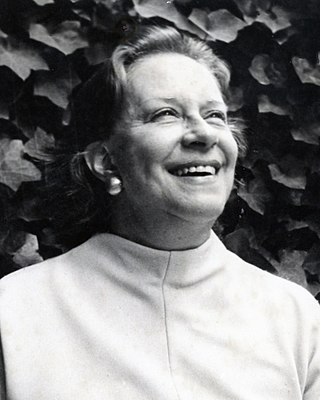
María Isabel Granda Larco, better known as Chabuca Granda, was a Peruvian singer and composer. She created and interpreted a vast number of Criollo waltzes with Afro-Peruvian rhythms.

El Poder del Norte is a Mexican norteño band which was formed in 1987 in Monterrey Nuevo León. It was formed by brothers Buenrostro Arturo, the accordionist, and Martin, the drummer.

Michael Salgado is a Norteño/Tejano music singer/accordionist.
Cecilia Bracamonte Chocano is a Peruvian singer. Her music genre is mainly Peruvian waltz which is the music heard in the main coastal cities. Her singing career spans more than four decades.
César Calvo Soriano was a Peruvian poet, journalist, and author. Calvo was part of the "Generación del Sesenta", a group of prominent Peruvian poets that came of age in the 1960s. Considered an important voice in the literature of Peru and the Amazon basin, his work has been celebrated in Latin America and a novel translated into Italian and English.
"La flor de la canela", commonly translated to the English language as "The Cinnamon Flower", is a Creole waltz composed by the Peruvian singer-songwriter Chabuca Granda.

Nube de Hielo translated as "Ice Cloud" is a traditional melody created by the Canarian composer Benito Cabrera. The song appeared for the first time published on the album «Notas de Viaje» in 1998, and since then it has been covered many times. The Canarians show a great of affection for this song, being deeply rooted in the Canary Islands.

Jairo[ˈxajɾo], pseudonym of Mario Rubén González Pierotti is an Argentine singer-songwriter and composer. Throughout his career, he has performed more than 500 songs in Spanish, French and Italian.

María Francisca Gavilán Valladares is a Chilean film, theater, and television actress and singer.
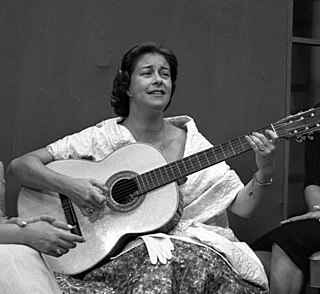
"Fina estampa" is a song written in 1956 by the Peruvian singer-songwriter, Chabuca Granda. The song is a Peruvian waltz in the "música criolla" style.
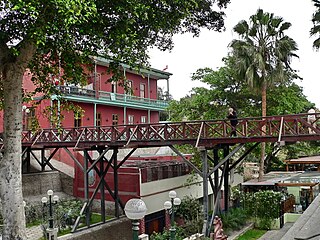
"El puente de los suspiros" is a song written and performed by Chabuca Granda. The song is a Peruvian waltz in the "música criolla" style.

"Lima de veras" is a song written in 1948 by Chabuca Granda. The song is a Peruvian waltz in the "música criolla" style. It was Granda's first published song and is regarded as one of her most important works.
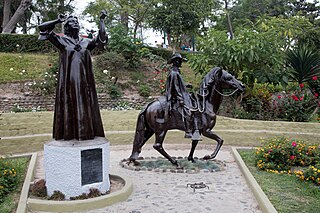
"José Antonio", sometimes also known as "Caballo de paso", is a song written and performed by Chabuca Granda. The song is in the tondero style. It was a tribute to friend of Granda's father and horse breeder who helped save the Peruvian Paso horse.

Cada Cancion con su Razon is a studio album by Chabuca Granda released on the EMI label in 1981.
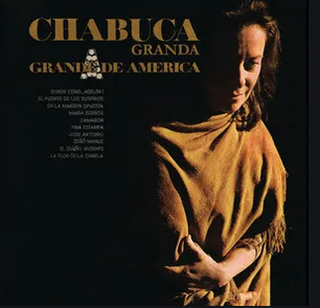
Grande De América is a studio album by Chabuca Granda released on the RCA Victor label in 1973.

Dialogandois a studio album by Peruvian singer and composer Chabuca Granda and Peruvian guitarist Óscar Avilés. The album was released in 1967 on the Iempsa label.

José Antonio de Lavalle y García was a Peruvian agronomist and horse breeder. He was the inspiration for Chabuca Granda's song José Antonio.
References
- ↑ Rodrigo Sarmiento Herencia (2020). Llego Rasgando Cielos, Luz y Viento: Vida y Obra de Chabuca Granda (PDF). Peru Ministro de Cultura. p. 86.
- ↑ T. Fuller; A. Rodriguez (1989). Chabuca Granda: Antología poética, Signo e imagen. Secretaría de Relaciones Institucionales del Banco de Crédito del Perú. p. 105.
- ↑ Sarmiento, "Llego Rasgando Cielos, Luz y Viento", pp. 144-145.
- ↑ Sarmiento, "Llego Rasgando Cielos, Luz y Viento", p. 184.
- ↑ "Las canciones de Chabuca Granda más emblemáticas en el año del centenario de su nacimiento". Caretas. January 24, 2020.
- ↑ "Chabuca Granda: las mejores canciones de la cantautora que representa al Perú". La Republica. January 10, 2020.
- ↑ "La lá interpreta "Cardo o ceniza" de Chabuca Granda como parte de RGP Latin Classics". Gladys Palmera. November 7, 2018.
- ↑ Sarmiento, "Llego Rasgando Cielos, Luz y Viento", p. 144.
- ↑ Sarmiento, "Llego Rasgando Cielos, Luz y Viento", p. 173.
- ↑ Sarmiento, "Llego Rasgando Cielos, Luz y Viento", p. 93.
- ↑ "Chabuca Granda Con Félix Casaverde, Caitro Soto* Y Ricardo Miralles* – Tarimba Negra". Discogs. Retrieved November 24, 2020.
- ↑ Rodrigo Sarmiento Herencia (2020). Llego Rasgando Cielos, Luz y Viento: Vida y Obra de Chabuca Granda (PDF). Peru Ministro de Cultura. pp. 96, 98.
- ↑ "Gifted: Women of the World". Allmusic.com. Retrieved November 24, 2020.
- ↑ "The Rough Guide to Afro Peru". Allmusic.com. Retrieved November 24, 2020.
- ↑ "Eva! Leyendra Peruana". Allmusic.com. Retrieved December 8, 2020.
- ↑ "Lo Inolvidable de Chabuca Granda". Allmusic.com. Retrieved November 24, 2020.
- ↑ "A Chabuca". Apple Music. Retrieved November 16, 2020.
- ↑ "Los peruanos que llevaron a Chabuca Granda a los 'Latin Grammy 2017'". RPP.pe. November 16, 2017.
- ↑ Guillermo Pellegrino (2002). Las cuerdas vivas de América. Editorial Sudamericana. p. 29.
- ↑ "Declaran Patrimonio Cultural de la Nación a la Obra musical de María Isabel Granda y Larco". El Peruano. January 5, 2017.
- ↑ "Chabuca Granda: las mejores canciones de la cantautora que representa al Perú". La República. September 3, 2019.
- ↑ "Las canciones de Chabuca Granda más emblemáticas en el año del centenario de su nacimiento". Caretas . January 24, 2020.
- ↑ Sarmiento, "Llego Rasgando Cielos, Luz y Viento", p. 11.